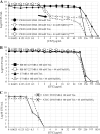Scope and Predictive Genetic/Phenotypic Signatures of Bicarbonate (NaHCO3) Responsiveness and β-Lactam Sensitization in Methicillin-Resistant Staphylococcus aureus
- PMID: 32041719
- PMCID: PMC7179597
- DOI: 10.1128/AAC.02445-19
Scope and Predictive Genetic/Phenotypic Signatures of Bicarbonate (NaHCO3) Responsiveness and β-Lactam Sensitization in Methicillin-Resistant Staphylococcus aureus
Abstract
Addition of sodium bicarbonate (NaHCO3) to standard antimicrobial susceptibility testing medium reveals certain methicillin-resistant Staphylococcus aureus (MRSA) strains to be highly susceptible to β-lactams. We investigated the prevalence of this phenotype (NaHCO3 responsiveness) to two β-lactams among 58 clinical MRSA bloodstream isolates. Of note, ∼75% and ∼36% of isolates displayed the NaHCO3 responsiveness phenotype to cefazolin (CFZ) and oxacillin (OXA), respectively. Neither intrinsic β-lactam MICs in standard Mueller-Hinton broth (MHB) nor population analysis profiles were predictive of this phenotype. Several genotypic markers (clonal complex 8 [CC8]; agr I and spa t008) were associated with NaHCO3 responsiveness for OXA.
Keywords: antimicrobial susceptibility testing; beta-lactams; methicillin-resistant Staphylococcus aureus; sodium bicarbonate.
Copyright © 2020 Ersoy et al.
Figures




Similar articles
-
Phenotypic and genotypic correlates of the sodium bicarbonate-responsive phenotype among methicillin-resistant Staphylococcus aureus isolates from skin and soft-tissue infections.Clin Microbiol Infect. 2025 Apr;31(4):588-593. doi: 10.1016/j.cmi.2024.11.034. Epub 2024 Dec 1. Clin Microbiol Infect. 2025. PMID: 39626860
-
Genomic investigation and clinical correlates of the in vitro β-lactam: NaHCO3 responsiveness phenotype among methicillin-resistant Staphylococcus aureus isolates from a randomized clinical trial.Antimicrob Agents Chemother. 2024 Jul 9;68(7):e0021824. doi: 10.1128/aac.00218-24. Epub 2024 Jun 5. Antimicrob Agents Chemother. 2024. PMID: 38837393 Free PMC article. Clinical Trial.
-
Ability of Bicarbonate Supplementation To Sensitize Selected Methicillin-Resistant Staphylococcus aureus Strains to β-Lactam Antibiotics in an Ex Vivo Simulated Endocardial Vegetation Model.Antimicrob Agents Chemother. 2020 Feb 21;64(3):e02072-19. doi: 10.1128/AAC.02072-19. Print 2020 Feb 21. Antimicrob Agents Chemother. 2020. PMID: 31844004 Free PMC article.
-
Bicarbonate Within: A Hidden Modulator of Antibiotic Susceptibility.Antibiotics (Basel). 2025 Jan 16;14(1):96. doi: 10.3390/antibiotics14010096. Antibiotics (Basel). 2025. PMID: 39858381 Free PMC article. Review.
-
The empirical combination of vancomycin and a β-lactam for Staphylococcal bacteremia.Clin Infect Dis. 2013 Dec;57(12):1760-5. doi: 10.1093/cid/cit560. Epub 2013 Aug 28. Clin Infect Dis. 2013. PMID: 23985343 Review.
Cited by
-
Phenotypic and genotypic correlates of the sodium bicarbonate-responsive phenotype among methicillin-resistant Staphylococcus aureus isolates from skin and soft-tissue infections.Clin Microbiol Infect. 2025 Apr;31(4):588-593. doi: 10.1016/j.cmi.2024.11.034. Epub 2024 Dec 1. Clin Microbiol Infect. 2025. PMID: 39626860
-
Impact of Bicarbonate on PBP2a Production, Maturation, and Functionality in Methicillin-Resistant Staphylococcus aureus (MRSA).Antimicrob Agents Chemother. 2023 May 1;65(5):e02621-20. doi: 10.1128/AAC.02621-20. Epub 2021 Mar 1. Antimicrob Agents Chemother. 2023. PMID: 33649115 Free PMC article.
-
A Combined Phenotypic-Genotypic Predictive Algorithm for In Vitro Detection of Bicarbonate: β-Lactam Sensitization among Methicillin-Resistant Staphylococcus aureus (MRSA).Antibiotics (Basel). 2021 Sep 9;10(9):1089. doi: 10.3390/antibiotics10091089. Antibiotics (Basel). 2021. PMID: 34572671 Free PMC article.
-
Measuring beta-lactam minimum inhibitory concentrations in Staphylococcus aureus in the clinical microbiology laboratory: pinning the tail on the donkey.J Clin Microbiol. 2024 Jan 17;62(1):e0036623. doi: 10.1128/jcm.00366-23. Epub 2023 Nov 15. J Clin Microbiol. 2024. PMID: 37966224 Free PMC article. Review.
-
Impact of Bicarbonate-β-Lactam Exposures on Methicillin-Resistant Staphylococcus aureus (MRSA) Gene Expression in Bicarbonate-β-Lactam-Responsive vs. Non-Responsive Strains.Genes (Basel). 2021 Oct 20;12(11):1650. doi: 10.3390/genes12111650. Genes (Basel). 2021. PMID: 34828256 Free PMC article.
References
-
- Fowler VG Jr, Sakoulas G, McIntyre LM, Meka VG, Arbeit RD, Cabell CH, Stryjewski ME, Eliopoulos GM, Reller LB, Corey GR, Jones T, Lucindo N, Yeaman MR, Bayer AS. 2004. Persistent bacteremia due to methicillin-resistant Staphylococcus aureus infection is associated with agr dysfunction and low-level in vitro resistance to thrombin-induced platelet microbicidal protein. J Infect Dis 190:1140–1149. doi:10.1086/423145. - DOI - PubMed

